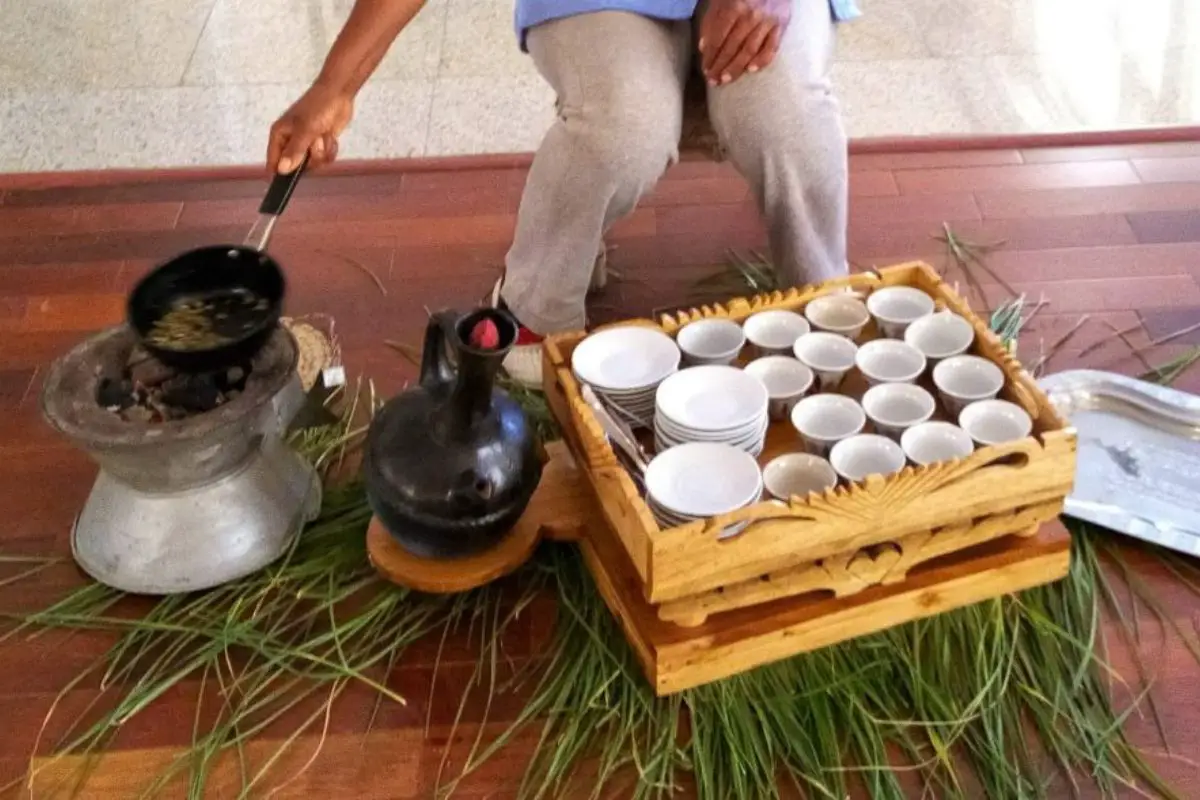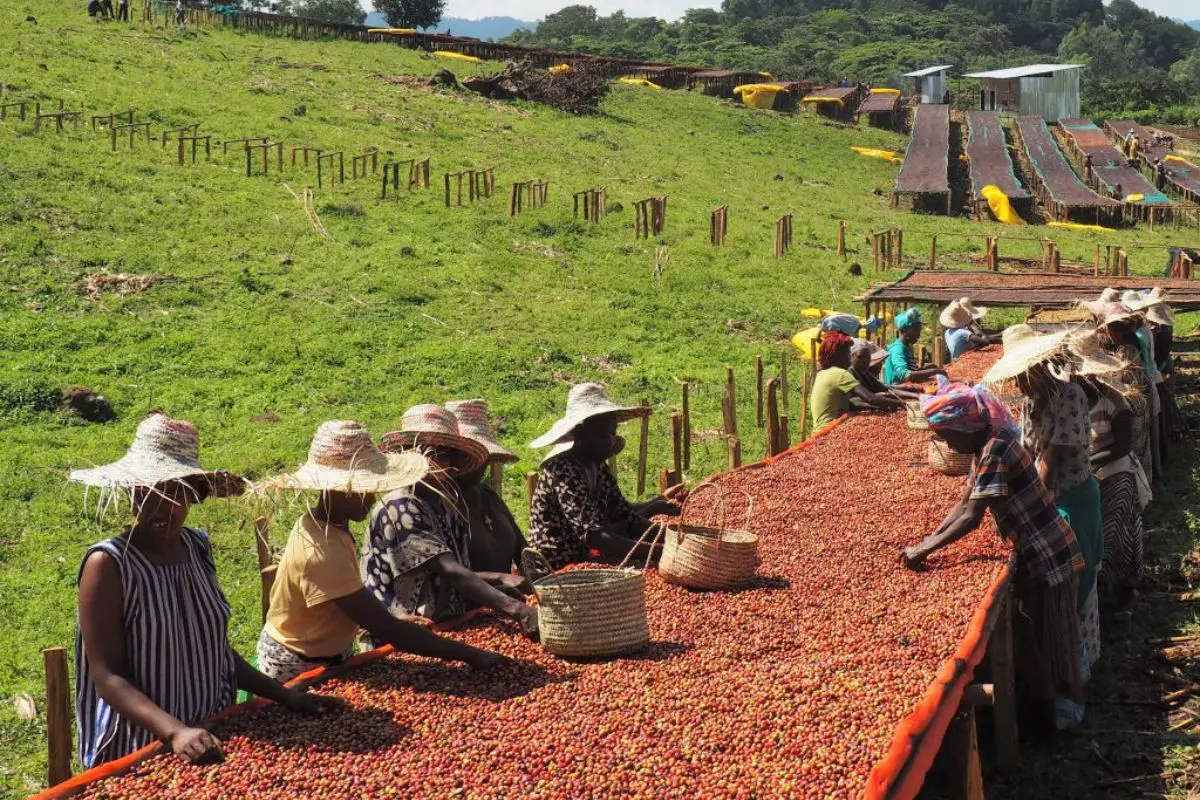Discover the rich history and culture of Ethiopian coffee, starting with its ancient origins and traditional ceremonies, and explore how these traditions have spread and shaped the global coffee consumption landscape. Learn about the unique characteristics of Ethiopian coffee beans, their flavor profiles, and the impact of the region’s geography on its beans. Delve into Ethiopian brewing techniques and immerse yourself in the modern adaptations that have emerged to celebrate Ethiopia’s vibrant coffee culture. By the end of this article, you’ll have a deeper understanding of the significant contributions Ethiopia has made to the world of coffee, and a greater appreciation for how its heritage continues to leave an enduring mark on coffee culture.

History of Ethiopian Coffee Culture
Origins of coffee in Ethiopia
The history of Ethiopian coffee culture dates back to thousands of years ago when it was first discovered and cultivated as a crop in the Kaffa region of Ethiopia. This region is believed to be where the Coffea arabica plant originates from, and the term “coffee” is often associated with the name of the region, Kaffa. Ethiopian coffee has a rich and storied history, beginning with the tale of its discovery by a young goat herder named Kaldi and his goats.
According to legend, Kaldi discovered the energizing properties of coffee while observing his goats. He noticed that his goats were unusually active and unable to sleep after eating the red berries of a particular plant. Intrigued by the berries’ effects on his goats, Kaldi shared his observations with a local monk who decided to brew the beans into a drink. The preparation provided the monk with the necessary stamina to stay awake during long hours of prayer. The word about these magical beans spread quickly, and coffee gained immense popularity throughout the monastic community.
As coffee’s reputation grew, its cultivation spread from the Kaffa region to other parts of Ethiopia, eventually becoming an integral part of Ethiopian culture. Communities throughout Ethiopia adopted coffee cultivation and began to utilize coffee beans for various purposes such as bartering, social engagement, religious practices, and medicinal uses.
Traditional Ethiopian coffee ceremony
The traditional Ethiopian coffee ceremony is a unique and symbolic social event that showcases the nation’s deep-rooted appreciation for coffee. The ceremony involves the ritualistic preparation and consumption of coffee, which brings family, friends, and neighbors together to chat, share stories, and engage in social bonding while enjoying coffee.
The process begins with the raw green coffee beans, which are roasted using an open flame in a specialized, flat pan called a menkeshkesh. As the beans turn dark and aromatic, the hostess will move the pan around the room, allowing guests to take in the delicious scent. The beans are then ground using a mortar and pestle or a traditional hand grinder called a mukecha.
The ground coffee is brewed in a unique, bulbous pot called a jebena over hot coals. Water is added gradually to the jebena, which is gently shaken to mix the coffee and water together. Once ready, the coffee is poured carefully from the jebena into small, handleless cups called sini. The coffee is typically served with sugar, salt, or even butter, and accompanied by traditional Ethiopian snacks like popcorn or fresh, baked bread.
The Ethiopian coffee ceremony is not merely about enjoying coffee, but also about appreciating the time spent together, fostering connections, and maintaining strong community bonds.
Role of coffee in Ethiopian society and economy
Coffee plays a significant role in Ethiopian society and the country’s economy. It serves as a source of livelihood for millions of Ethiopians, as well as a pillar of sociocultural identity. Coffee production is Ethiopia’s largest industry, accounting for up to 30% of the country’s export earnings. Ethiopia is the largest coffee producer in Africa and the fifth largest in the world.
In addition to its economic significance, coffee holds an essential place in Ethiopian society, transcending social, cultural, and religious barriers. From the traditional coffee ceremony to daily coffee breaks, coffee is an essential element of Ethiopian life, deeply woven into the fabric of the nation’s identity.
Spread of Ethiopian coffee culture to the world
The influence of Ethiopian coffee culture has expanded far beyond the country’s borders over the centuries. Arab traders and European explorers who came into contact with Ethiopian coffee in the 15th and 16th centuries helped to spread it across the globe. Yemen, in particular, played a crucial role in spreading Ethiopian coffee culture to the Arab world, where coffee drinking became an integral social and cultural practice.
European explorers and traders are responsible for introducing coffee to Europe, where it spread rapidly, spurred innovations in brewing technology, and gave rise to coffeehouses, which became important social gathering places for intellectual and political discussions.
Today, Ethiopian coffee is lauded around the world for its rich flavor and unique cultural heritage. Specialty coffee shops often showcase Ethiopian coffee and the traditional coffee ceremony, allowing coffee enthusiasts to experience a taste of Ethiopia’s rich history and its deep appreciation for the beloved beverage.
Characteristics of Ethiopian Coffee Beans

Ethiopian coffee is one of the most prized coffee origins in the world. The unique geographical features of the region, the diverse coffee varietals, traditional processing methods, and focus on sustainability produce beans with exquisite taste profiles.
Geographical factors influencing coffee flavors
Ethiopia is regarded as the birthplace of coffee, and the favorable geographical factors contribute to the sensory complexity of its coffee beans. The country is characterized by its high-altitude ranges of 1500 to 2500 meters above sea level, particularly in the major coffee-producing regions like Sidama, Yirgacheffe, Harrar, and Limu. These altitudes, paired with the mineral-rich volcanic soil, create an ideal environment for coffee plants to thrive.
High-altitude coffee beans tend to be denser and, as a result, exhibit more complex and nuanced flavor profiles. Additionally, the slow maturation process at high altitudes allows the coffee cherries to develop a higher concentration of sugars, resulting in a sweeter and more vibrant coffee. Ethiopian coffee displays a wide range of flavors, often characterized by floral, fruity, and wine-like notes. The unique terroir in different regions of Ethiopia is responsible for producing exciting flavor characteristics that are beautifully distinct from one another.
Varietals of Ethiopian coffee and their taste profiles
Ethiopia is home to a diverse range of coffee varietals, which result in unique taste profiles depending on the region they are grown in. The most noteworthy Ethiopian coffee-producing regions are Sidama, Yirgacheffe, Harrar, and Limu.
Sidama is known for its coffee beans with bright acidity and a balanced body. The coffee from this region often displays notes of citrus, honey, and floral undertones.
Yirgacheffe is perhaps the most famous coffee region in Ethiopia, producing elegant coffee with vibrant acidity and delicate floral and fruit notes, like jasmine, bergamot, and stone fruits.
Harrar is characterized by its wild and sun-dried coffee beans, which result in a bold, full-bodied coffee with fruity and wine-like flavors. Typical taste notes include blueberries, apricots, and dark chocolate.
Limu is recognized for producing washed coffee with a well-balanced body, mild acidity, and fruity and floral flavors, such as peach, tangerine, and jasmine.
Processing methods in Ethiopia
Traditional Ethiopian coffee processing methods contribute significantly to the diverse taste profiles found in their beans. Two primary processing methods are practiced in Ethiopia: natural (dry) and washed (wet) processes.
In the natural process, coffee cherries are harvested and spread out to dry in the sun for several weeks, allowing the fruit to ferment around the coffee seed. Once sufficiently dry, the outer layers are removed, and what remains is the raw, green coffee bean. This method often produces a more fruity and wine-like flavor profile in the coffee.
On the other hand, the washed process involves removing the coffee cherry’s fruit layers before drying, and the beans are immediately soaked in water to ferment. Washed Ethiopian coffees are known for their crisp acidity, well-defined flavors, and a cleaner taste profile compared to naturally processed coffees.
Sustainably sourcing Ethiopian coffee
Sustainability plays a crucial role in Ethiopian coffee production. Many Ethiopian coffee farms are smallholder farms that rely on traditional farming methods, without the use of chemical fertilizers or pesticides. These practices translate to organic coffee production that protects the environment and supports biodiversity.
Moreover, several organizations work with Ethiopian coffee farmers to establish fair trade practices, ensuring that farmers receive fair prices for their crops. These organizations also encourage economic, social, and environmental sustainability by investing in better agricultural practices, education, and community development.
By sourcing sustainably produced Ethiopian coffee, consumers support both the environment and the livelihoods of the smallholder farmers that have proudly cultivated these exceptional beans for centuries.
Impact of Ethiopian Coffee Culture on Global Coffee Consumption
Adoption of Ethiopian coffee brewing techniques worldwide
Ethiopia is widely regarded as the birthplace of coffee, and its rich coffee culture has played a significant role in shaping global coffee consumption habits. Ethiopian coffee brewing techniques, such as the traditional Ethiopian coffee ceremony, have been adopted by coffee enthusiasts around the world. This ancient ritual involves roasting coffee beans manually and brewing the coffee in a traditional clay pot called a jebena. Aspects of this coffee brewing process have gained popularity worldwide, with many coffee shops and homebrewers adopting these techniques. In many countries, coffee houses offer their customers an authentic Ethiopian coffee experience by roasting beans on-site and serving coffee in traditional jebena pots. This has helped introduce the unique flavors of Ethiopian coffee to a wider audience and expand the global coffee market.
Specialty coffee shops and the influence of Ethiopian coffee
The rise of specialty coffee shops in the 21st century has contributed significantly to the spread of Ethiopian coffee culture around the world. Growing interest in specialty coffee has resulted in increased demand for coffee beans sourced from Ethiopia. In particular, single-origin Ethiopian coffee beans are highly sought after by consumers for their distinct flavor profiles and wide range of tasting notes. These beans are commonly used in pour-over brewing methods, such as the Hario V60 or the Chemex, which help accentuate the beans’ unique attributes. As a result, Ethiopian coffee has become synonymous with the specialty coffee movement, and the region has garnered a reputation for producing some of the world’s finest coffee beans.
Coffee education and the role of Ethiopia
As coffee has become a staple beverage around the world, interest in coffee education has grown. Many professional baristas and coffee lovers now seek formalized training to learn about various areas related to coffee. This includes subjects such as brewing techniques, roasting fundamentals, and coffee bean origins. Ethiopia has played a significant role in coffee education, with many instructors highlighting the importance of the country in the history and development of coffee. Knowledge of the distinct flavor profiles and sourcing of Ethiopian coffee beans is considered a core aspect of coffee education for professionals and enthusiasts alike. This emphasis on Ethiopian coffee in educational programs further solidifies the country’s influence on the broader coffee culture.
Ethiopian coffee in popular culture and media
The impact of Ethiopian coffee culture is also evident in popular culture and media. Books, documentaries, and films about coffee often feature the unique aspects of Ethiopian coffee and its central role in the birth and development of coffee as a global beverage. For example, the popular documentary film “Black Gold” (2006) highlights the struggles of Ethiopian coffee farmers and their essential part in the global coffee industry. This increased media attention has drawn awareness to the importance of Ethiopian coffee and further solidified its status as a key player in worldwide coffee consumption.
Overall, Ethiopian coffee culture has had a significant impact on global coffee consumption. Through the adoption of traditional brewing techniques, the rise of specialty coffee shops, the role of Ethiopia in coffee education, and the representation of Ethiopian coffee in popular culture, the country’s unique coffee culture continues to shape and influence the way people around the world enjoy and consume coffee.
Ethiopian Coffee Brewing Techniques

Ethiopia is considered the birthplace of coffee, and as such, it is no surprise that Ethiopian coffee brewing techniques hold a special place in the coffee world. Ethiopian coffee is some of the most diverse and exciting coffee found today. To be able to fully appreciate it, it is essential to understand the variety of brewing techniques that have been developed and refined over generations. This article will explore several traditional Ethiopian coffee brewing methods, tools used, and the steps involved in Jebena brewing. It will also discuss coffee roasting and grinding techniques specific to Ethiopia and tips for optimizing coffee extractions with Ethiopian beans.
Traditional brewing methods and tools
Ethiopian coffee brewing techniques demand a certain degree of ceremony and tradition. Most coffee rituals in Ethiopia are called “Buna” (the Amharic word for coffee). A Buna ceremony involves several essential tools and brewing methods that have been passed down through generations. The key tools used in Ethiopian coffee brewing include:
- Jebena: A traditional clay coffee pot with a round bottom, slender neck, and a spout, used for brewing coffee. The Jebena is often beautifully decorated and is a centerpiece of the ceremony.
- Pan or skillet: Used for roasting the coffee beans on an open fire, ensuring even roasting and heating.
- Mortar and pestle: A traditional grinding tool made from stone or wood, used to grind the freshly roasted coffee beans.
- Sini: Small, handle-less cups made from porcelain, glass, or clay, used for serving the coffee.
- Rekebot: A small, beautifully decorated table used to hold the Jebena, cups, and other coffee-making implements.
Jebena brewing: step-by-step guide
Jebena brewing is the most traditional Ethiopian coffee brewing method. The process includes the following steps:
- Roast the green coffee beans: Place the green coffee beans in a pan or skillet and slowly roast them over an open fire or stove. Stir the beans constantly to ensure even roasting. Once the beans have reached a uniform, medium-dark brown color, remove them from the heat and transfer them to a plate to cool.
- Grind the roasted beans: Using a mortar and pestle, grind the roasted coffee beans into a fine powder. Be mindful not to grind the beans too coarse, as this may result in a weak brew.
- Heat the water: Fill the Jebena with water and place it over the heat source to reach the desired temperature. Traditionally, the water should reach a temperature just below boiling (around 195°F or 90°C).
- Mix the coffee ground and hot water: Once the water has reached the desired temperature, slowly stir in the ground coffee. Allow the mixture to steep for a few minutes.
- Pour the brewed coffee: A traditional Ethiopian coffee ceremony concludes by pouring the freshly brewed coffee into small cups (Sinis) using a slow, steady stream to create a frothy top. Traditionally, sugar is then added to the coffee, and sometimes spices such as cinnamon and cardamom can be included for additional flavor.
Coffee roasting and grinding techniques in Ethiopia
In Ethiopia, coffee roasting and grinding techniques play a significant role in showcasing the unique flavors of the coffee beans. Roasting the beans at home allows for a personal connection to the brewing process and results in fresher, more vibrant flavors. Ethiopian home roasting involves stirring the beans constantly to achieve a uniform color and spread the heat evenly. This method ensures that the roasting process accentuates the coffee’s inherent flavor profile.
Grinding the beans is another crucial aspect of Ethiopian coffee preparation. Traditional mortar and pestle grinding emphasizes the hand-crafted nature of the brewing process. The goal is to achieve a fine, even grind to ensure a smooth, well-extracted coffee. The mortar and pestle provide a level of control and precision that cannot be matched by electric grinders.
Optimizing coffee extractions with Ethiopian beans
To fully appreciate the unique flavor profiles of Ethiopian coffee beans, several factors should be considered when optimizing coffee extractions. These factors include water temperature, brewing time, and grind size.
- Water temperature: Ethiopian coffee beans shine when brewed at a temperature just below boiling (around 195°F or 90°C). A slightly lower temperature allows for the complex flavor compounds to be fully extracted without over-extraction or bitterness.
- Brewing time: Allowing the coffee to steep for a few minutes is crucial to achieving a well-extracted brew. Typically, 3-5 minutes of steeping time is sufficient to extract the desired flavors and aromas without over-extracting the beans.
- Grind size: A fine grind is recommended to achieve a smooth, well-extracted cup of Ethiopian coffee. However, the grind size should be adjusted based on the specific brewing method used (Jebena, French press, pour-over, etc.). Keep in mind that a finer grind may require a shorter steeping time, while a coarser grind will need a longer steeping time.
By following these guidelines, you can enjoy the complex flavors, rich aroma, and intricate nuances of Ethiopian coffee beans in every cup. Embrace the tradition and craftsmanship of Ethiopian coffee brewing techniques, and discover why Ethiopian coffee is revered worldwide.
Modern Adaptations of Ethiopian Coffee Culture
The Ethiopian coffee culture has a rich history that dates back to the origins of coffee itself. As the birthplace of coffee, Ethiopia has a unique and vibrant coffee culture that has been preserved throughout generations. In recent years, there have been numerous modern adaptations to Ethiopian coffee culture, incorporating aspects of the traditional way of preparing and enjoying coffee with innovative new ideas.
Innovative brewing techniques inspired by Ethiopia
Traditional Ethiopian brewing techniques involve a coffee ceremony that includes roasting the beans, brewing them in a clay pot called a jebena, and serving the coffee in small cups with sugar, salt, or honey. Modern adaptations to these techniques have been incorporated into the global coffee scene, making the Ethiopian coffee experience more modern and accessible.
Some innovations include the use of specialty brewing equipment like pour-over stands, syphons and Aeropress, which allow for precision and control over the brewing process. The Ethiopians’ slow, manual brewing techniques are also inspiring many baristas around the world to experiment with similar methods to extract the rich flavors in their coffee. The focus on direct, single-origin coffee has also gained prominence, with many small scale roasters now offering single-origin Ethiopian beans.
Creative coffee recipes with Ethiopian influences
Ethiopian coffee culture has inspired several unique and experimental recipes that marry the flavors of Ethiopia’s traditional ingredients with modern trends. Some inventive coffee recipes include spiced coffee with popular Ethiopian ingredients like cinnamon, ginger, nutmeg, and cloves to enhance the natural flavors of Ethiopian coffee. Some coffee shops have also introduced traditional Ethiopian drinks like tej, a honey wine, as a coffee cocktail ingredient.
Another trendy Ethiopian-inspired coffee creation is the use of nitro-infused coffee, where Ethiopian coffee blends are infused with nitrogen gas, creating a velvety texture and smooth flavor profile. The cascading effect from the nitrogen infusion gives the drink an attention-grabbing visual attraction, making it a unique offering for global coffee enthusiasts.
Collaborations between Ethiopian coffee producers and global brands

Ethiopian coffee has garnered significant international attention, leading to various collaborations between Ethiopian coffee producers and global brands. These collaborations aim to increase the visibility and accessibility of Ethiopian coffee, as well as invest in sustainable practices and provide more equitable incomes to Ethiopian farmers.
For example, Starbucks launched the “Ethiopia” blend in 2013, a single-origin coffee that highlights the unique flavors of Ethiopian beans. Nespresso also added Ethiopian coffee to their master origin series, with the “Ethiopia Yirgacheffe” being one of their popular offerings. These collaborations have helped increase the global awareness of Ethiopian coffee while providing support to the coffee farmers and communities responsible for producing these exceptional beans.
Promotion of Ethiopian coffee tourism
The Ethiopian government is actively encouraging and promoting coffee tourism to showcase the origins of coffee and the unique coffee culture that Ethiopia has to offer. Coffee tours can include visits to coffee farms, attending the Ethiopian coffee ceremony, and even travel to the Kaffa region, where coffee is believed to have originated.
Visitor experiences like the Coffee Arabica Origin Tour and the Kew Gardens Coffee Trail celebrate Ethiopia’s coffee heritage and allow tourists to learn firsthand about the country’s rich coffee history. Coffee tourism is a promising industry that can have significant economic benefits for Ethiopia, promoting cultural exchange and providing employment opportunities to local communities.
In summary, modern adaptations of Ethiopian coffee culture have led to innovation in brewing techniques, coffee recipes, and collaborations with global brands. Ethiopia’s unique coffee customs have influenced the global coffee scene and inspired a new generation of coffee enthusiasts. With increased interest in Ethiopian coffee and the promotion of coffee tourism, the industry is experiencing growth, fostering sustainable practices and providing economic benefits to the communities responsible for producing these exceptional beans.
FAQs on The Influence of Ethiopian Coffee Culture on Modern Coffee Brewing Techniques
How did Ethiopian coffee culture contribute to the development of modern brewing techniques?
The Ethiopian coffee ceremony’s methods of roasting, grinding, and brewing coffee beans have directly influenced modern methods such as espresso extraction and pour-over techniques. The use of fresh, locally sourced beans has also become a key component in specialty coffee (Bachke, 2020).
What is the significance of the Ethiopian coffee ceremony in the global coffee industry?
The Ethiopian coffee ceremony fosters a deep appreciation for coffee quality and ritual, emphasizing the importance of these aspects in the global industry. This ceremony has inspired contemporary brew bars, where customers can observe detailed brewing techniques and enjoy the cultural experience (Bachke, 2020).
What impact has Ethiopian coffee culture had on the growth of specialty coffee shops?
Ethiopian coffee culture has significantly impacted specialty coffee shops by emphasizing the value of the coffee experience, bean quality, and brewing methods. Adopting these values allows specialty coffee shops to offer unique experiences and distinguish themselves from traditional coffeehouses (Pan, 2020).
How does the Ethiopian coffee ceremony’s serving style influence modern coffee presentation?
The Ethiopian coffee ceremony uses a Jebena to brew the coffee, which is then served in small, handleless cups. This distinctive presentation has influenced modern specialty coffee shops to offer handcrafted brewing and serving options, enhancing the customer experience (Bachke, 2020).
How did Ethiopian coffee culture help shape the communal aspect of coffee drinking in modern society?
The Ethiopian coffee ceremony underscores the communal aspect of coffee by celebrating connection and conversation. Modern coffee shops often adopt an ethos of hospitality and community, fostering spaces where people can socialize, relax, and work (Pan, 2020).
Are there traditional Ethiopian brewing techniques that are still widely used outside of Ethiopia?
Yes, the Ethiopian coffee ceremony’s techniques, particularly the use of freshly roasted coffee beans and the pour-over brewing method, are still used worldwide. These techniques are particularly prevalent among specialty coffee shops and artisan roasters (Bachke, 2020).